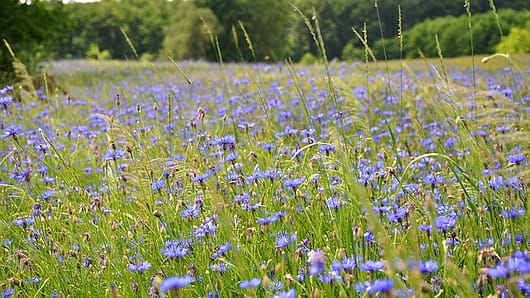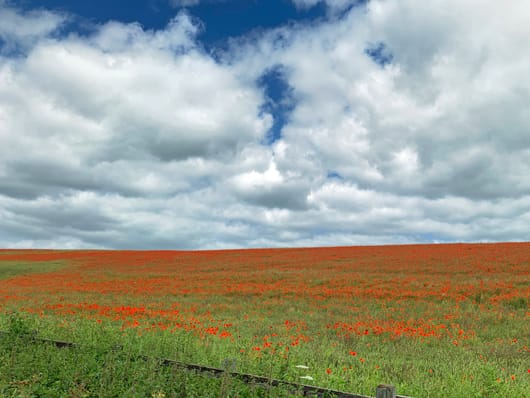Everyone at The Oxfordshire Gardener has their own special area of interest and expertise, and with autumn being spot-on for sowing a wildflower meadow, what better time to catch-up with our resident wildflower whisperer, Sasha.

Working in Gardens
As the Autumn Equinox fades into the background, and the days are getting shorter it brings around a good time of the year to reflect back on the highs and lows of the experiences you’ve had during the year in many aspects of your daily life.
For me, I feel most at home when I am outside, whether that be indulging in a scented rose garden, ambling through a wildflower meadow or ancient woodland, or just sat watching the birds in the garden.
I believe it is a real privilege in life to find a job that not only lets me do some of these things, but also encourages you to learn new things everyday, and holds your attention in a way that nothing else does.
Making Wildflower Meadows

It was during my time working in a conservation role that I discovered one of my first true passions in the natural and working world, that being wildflower meadows.
One of the more poignant definitions I have come across for wildflower meadows is…
‘Grassland that has been left untreated and unimproved with the aid of chemicals, but instead altered through natural human activity, such as livestock grazing or hay-cutting’
…which very nearly sums up the perfect way to care for a wildflower meadow, but is also not dissimilar to general assumptions that are made about these spectacular meadow areas.
It is very important to take note that simply leaving a ‘long grass area’ uncut throughout the year is not exactly a meadow, well, not a very beneficial one.
Ideally, a wildflower meadow should be cut or grazed once a year, in late-summer, after the seed heads have dropped and have found a nice spot to nestle on the earth ready to put on a show for the next year! Although, if you have an existing wildflower meadow that you know needs improvement, an early spring cut would be most beneficial too, in reducing over-competitive grasses and giving wildflowers a fighting chance.
Alternatively, if you don’t yet have a wildflower meadow, October is a perfect time to consider adding wildflower seed to a prepared area of earth, (or a wildflower turf) ready to settle in for the next season; or you can do this in early spring March/April time in preparation for it to bolt into life for that summer season!
Meadow Magic

I find real joy in looking upon a wildflower meadow. I believe they truly reflect something magical, often perform their best on the most infertile soil; something good coming from something bad. And if there is nothing else that various heartaches through life has taught me, it has taught me to look for something good amidst something bad. Wildflower meadows truly exhibit this notion.
One of the most notable symbolic aspects of a native meadow is the instantly recognisable red poppy, which appeared in a blanket-like fashion over the villages and fields that were decimated in the First World War.
The poppy is the true embodiment of something beautiful emerging from something so devastating; a fundamental hope that many people cling to in their daily lives.
Pollinators Paradise
As times have changed and everything has become busier and more hectic, the value of our native species, both plant and animal, has increased tenfold.
The symbiosis between wildflower meadows and the smallest to the largest of sentient beings is incalculable. It is essential to the existence of every living thing on this planet.
The decline of pollinators is a topic that should be discussed far and wide, more so than any manmade catastrophe, as pollinators are intrinsic to thousands of ecosystems and food chains, including our own!

By creating wildflower meadows in any appropriate aspect of our surroundings, whether that be small or large areas in gardens or enormous meadows on hillsides and parkland landscapes, it’s a sure-fire way to help combat this issue, providing plants for pollination, and if nothing else habitats for those who need them.
In order to evolve as a race we must step back in our ancestry and seek out our connection to the natural world, investing in a more symbiotic relationship, as opposed to blundering through in the same fashion that has cost us so much in the last century, including 97% of our wildflower meadows since the 1930’s.
I for one make it a goal in life to do this.
Sasha is currently busily working in gardens across our portfolio, creating wildflower meadows, as well as providing regular, methodical garden care & maintenance to the wider garden.
Discover how The Oxfordshire Gardener’s wildflower meadow whisperer could bring the bees to your garden. Say hello!


